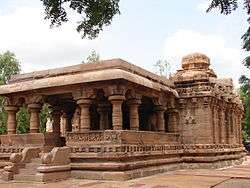Parshvanatha
| Parshvanatha | |
|---|---|
| 23rd Jain Tirthankara | |
|
Image of Tīrthankara Parshvanatha (Victoria and Albert Museum, 6th-7th Century) | |
| Symbol | Snake |
| Height | 9 cubits (13.5 feet)[1] |
| Age | 100 years |
| Color | Blue |
| Spouse | Prabhavati[2] |
| Parents |
|
| Preceded by | Neminatha |
| Succeeded by | Mahavira |
| Born | Varanasi |
| Moksha | Shikharji |
| Part of a series on |
| Jainism |
|---|
 |
|
Jain prayers |
|
Ethics |
|
Major figures |
|
Major sects |
|
Festivals |
|
Pilgrimages |
|
|
Parshvanatha (Pārśvanātha), also known as Parshva (Pārśva), was the twenty-third Tirthankara of Jainism.[3][4] He is the earliest Jain leader (c. 872 – c. 772 BCE) for whom there is reasonable evidence of having been a historical figure.[5][6]
Historicity
Circumstantial evidence including a description of the teachings of Parshvanatha in the Sayings of the Seers, dictates that Parshvanatha can be viewed as a historical figure.[7][8][9][10][11][12][13]
Biography
Parshvanatha was born on the tenth day of the dark half of the month of Paush to King Asvasena and Queen Vamadevi of Benaras (now Varanasi).[14][7][15] He belonged to the Ikshvaku dynasty.[16][17] He assumed and began to practice the twelve basic vows of the adult Jain householder when he reached the age of eight.[18]
Parshvanatha lived as formal prince of Varanasi and at the age of thirty, he renounced the world to become a monk.[19] He meditated for eighty-four days before attaining Kevalay gyan.[20] He achieved moksha at the age of one hundred atop Shikharji,[7][15] which is known today as the Parasnath Hills after him. Parshvanatha was called purisādāṇīya (beloved of men), a name which shows that he must have been a genial personality.[16] He remains beloved among Jains.[21]
Previous Births
- Marubhuti - Visvabhuti, the prime minister of King Aravinda had two sons, elder one named Kamath and younger one named Marubhuti (Parshvanatha). Kamath killed Marubhuti and died as a criminal.[22]
- Elephant - He was then reborn as an elephant in the forests of Vindyachal. His name was Vajraghosha (Thundering Voice of Lightening). Meanwhile, King Aravinda, after death of his minister Marubhuti, renounced his throne and was leading an ascetic life. When the elephant came near Aravinda, he recalled his previous human life by the blessings of Aravinda and became calm. Kamath was reborn as a serpent this time.[23] One day, when the elephant went to a river to quench his thirst, the serpent attacked him and he died the peaceful death of absolute renunciation.[24]
- Sasi-prabha - Vajraghosha was reborn as Sasi-prabha (splendor of the moon) in the twelfth heaven and the serpent went to hell.[24]
- Agnivega - After spending a luxurious life in heaven, he was reborn as prince Agnivega (strength of fire). He ascended the throne of his father which he later renounced to lead an ascetic life. Kamath was reborn as a serpent again after hell and again killed the ascetic in Himalayas during penance.[25]
- When he was a prince he saved two snakes that had been trapped in a log in an Kamath’s fire. Later, the snakes were reborn as Dharnendra, the lord of the underworld kingdom of the nāgas, and Padmavati. Dharnendra and Padmavati sheltered Parshvanatha from a storm sent by a Meghmali (Kamath reborn).[26]
Teachings
According to the Kalpa Sūtra, Parshvanatha had 164,000 śrāvakas (male lay followers) and 327,000 śrāvikās (female lay followers) and 16,000 sādhus (monks) and 38,000 sādhvīs (nuns). He had eight ganadharas (chief monks): Śubhadatta, Āryaghoṣa, Vasiṣṭha, Brahmacāri, Soma, Śrīdhara, Vīrabhadra and Yaśas. After his death, the ganadhara Śubhadatta became the head of the monastic order. He was then succeeded by Haridatta, Āryasamudra and Keśī.[19]
Śvētāmbara texts explain that a sage named, Keśī was born about 166 to 250 years after the death of Parshvanatha met the Indrabhuti Gautama, the chief disciple of Mahavira and asked him twelve questions.[27] One of the question as mentioned in Śvētāmbara text was "The Law taught by the great sage Parsva, recognises but four vows, whilst that of Vardhamana enjoins five". Therefore, according to Śvētāmbara texts, Parshvanatha taught four vows instead of the presently famous five vows (mahavratas).[28] This view is however not accepted by the Digambaras. On this, Champat Rai Jain in his essay titled "The Origin of The Swetambara Sect" wrote:
The first question Kesi put to Gautam was why did Mahavira insist upon the observance of five vows when Parashvanath did not mention five but only four, excluding celibacy? But the question would have had a point if it could be shown that salvation could be obtained without the observance of celibacy. So far as I understand Swetambara books themselves insist upon an observance of this vow, and it is not possible that two omniscient teachers, i. e., Parashvanath and Mahavira could teach different things.
In literature
Acharya Jinasena's Mahapurāṇa include Ādi purāṇa and Uttara-purāṇa. It was completed by Acharya Gunabhadra, the disciple of Jinasena in the 8th century C.E. In Ādi purāṇa, life events of Rishabhanatha, Bahubali and Bharata are detailed out.[30]
Kalpa Sūtra is biographies of the Jain Tirthankaras, notably Parshvanatha and Mahavira.
Guru Gobind Singh has penned life history of Parshvanatha in a composition called the Paranath Avtar, which is included in the Dasam Granth.[31]
Iconography
Parshvanath is the most popular object of Jain devotion. He is closely associated with compassion, although he is free from the world of rebirth like all Tirthankaras and therefore unable to aid his devotees personally.[32]
Temples
-
Parshvanatha basadi (1133 AD) at Halebidu
-
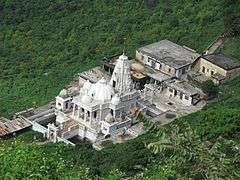
Jal Mandir, Shikharji
- Shikharji (Sammet Sikhar) in Jharkhand
- Shri Shankeshwar Tirth
- Andeshwar Parshwanath in Rajasthan
- Lal Mandir in Chandni Chowk, Delhi
- Bada Gaon
- Kallil Temple, Kerala
- Navagraha Jain Temple in Hubli, Karnataka
- Ahi Kshetra
Idols
-
Parshvantha, Government Museum, Mathura, Kushan Period, 2nd century
-

Satna museum, 5th century
-
Tīrthankara Parshvanatha, Maharaja Chhatrasal Museum, 11th century
-
Akota Bronzes, Honolulu Academy of Arts, 7th century
-
Tirthankara Parsvanatha, Government Museum, Mathura, 5th-8th century
-
Sculpture with image of Parshvanatha, Thirakoil, 8th Century
-
Kalugumalai Jain Beds, 8th century
-
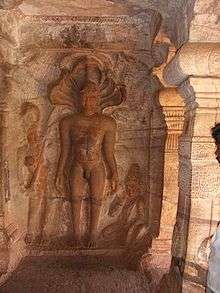
Parsvanath Image, Badami caves, Karnataka
-

Parsvanatha, Akota, National Museum, New Delhi, 9th Century
-

Jain Altarpiece with Parshvanatha, Mahavira and Neminatha, LACMA, 10th century
-

Tirthankara Parsvanatha, Linden Museum, 10th-11th Century
-

Parsvanatha idol at Lodhruva
-
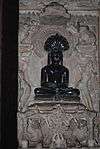
Parshwanath Temple at the Khajuraho Group of Monuments
-

5 feet tall idol of the Parshwanath Akkana Basadi, 12th century
-

Brass idol of tirthankar Parshvanatha in Walters Art Museum, 16th century
Colossal statues
-

31 feet Parshvanatha Vahelna Statue
-

18 feet idol of Parsvanatha in Parsvanatha Basadi at Shravanabelgola
-
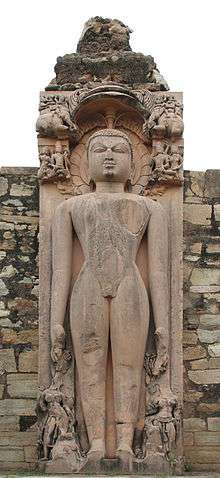
17.5 feet statue of Parshavanatha at Naugaza Digambar Jain Temple, Alwar, Rajasthan
See also
| Wikimedia Commons has media related to Parshvanatha. |
Notes
- ↑ Sarasvati 1970, p. 444.
- ↑ "Parshvanath-the 23rd tirthankar", indianscriptures.com
- ↑ Fisher 1997, p. 115.
- ↑ Sanghvi, Vir, "Rude Travel: Down The Sages", Hindustan Times
- ↑ Zimmer 1953, p. 183.
- ↑ Sangave 2001, p. 103.
- 1 2 3 Dundas 2002, p. 30.
- ↑ Sangave 2001, p. 128.
- ↑ Charpentier 1922, p. 153.
- ↑ Ghatage 1951, p. 411-412.
- ↑ Deo 1956, pp. 59–60.
- ↑ Zimmer 1953, p. 182-183.
- ↑ Zimmer 1953, p. 220.
- ↑ Zimmer 1953, p. 184.
- 1 2 Sangave 2001, p. 104.
- 1 2 Ghatage 1951, p. 411.
- ↑ Deo 1956, p. 60.
- ↑ Zimmer 1953, p. 196.
- 1 2 von Glasenapp 1999, pp. 24–28.
- ↑ Danielou 1971, p. 376.
- ↑ Schubring 1964, p. 220.
- ↑ Zimmer 1953, p. 186-187.
- ↑ Zimmer 1953, p. 189.
- 1 2 Zimmer 1953, p. 190.
- ↑ Zimmer 1953, p. 191.
- ↑ "Parshvanatha". Encyclopædia Britannica.
- ↑ von Glasenapp 1999, p. 35.
- ↑ Chatterjee, Asim Kumar (2000). A Comprehensive History of Jainism. ISBN 9788121509312.
- ↑ Champat Rai Jain. The Change of Heart. p. 102–103.
- ↑ Upadhye, Dr. A. N. (2000). Mahāvīra His Times and His philosophy of life. Bharatiya Jnanpith. p. 46.
- ↑ Dasam Granth, S.S. Kapoor, Page 17
- ↑ Bowker 1997.
References
- Bowker, John (1997), World Religions, New York City: DK Publishing, Inc.
- Charpentier, Jarl (1922), "The History of the Jains", The Cambridge History of India, 1, Cambridge
- Danielou, A (1971), L'Histoire de l'Inde Translated from French by Kenneth Hurry, ISBN 0-89281-923-5
- Deo, Shantaram Bhalchandra (1956), History of Jaina monachism from inscriptions and literature, Pune: Deccan College Post-Graduate and Research Institute
- Dundas, Paul (2002) [1992], The Jains (Second ed.), London and New York City: Routledge, ISBN 0-415-26605-X
- Fisher, Mary Pat (1997), Living Religions: An Encyclopedia of the World's Faiths, London: I.B.Tauris, ISBN 1-86064-148-2
- Ghatage, A.M. (1951), "Jainism", in Majumdar, R.C.; Pusalker, A.D., The Age of Imperial Unity, Bombay
- Sangave, Vilas Adinath (2001), Facets of Jainology: Selected Research Papers on Jain Society, Religion, and Culture, Mumbai: Popular Prakashan, ISBN 978-81-7154-839-2
- Sarasvati, Swami Dayananda (1970), An English translation of the Satyarth Prakash, Swami Dayananda Sarasvati
- Schubring, Walther (1964), Jinismus, in: Die Religionen Indiens, 3, Stuttgart
- von Glasenapp, Helmuth (1999), Jainism: An Indian Religion of Salvation [Der Jainismus: Eine Indische Erlosungsreligion], Shridhar B. Shrotri (trans.), Delhi: Motilal Banarsidass, ISBN 81-208-1376-6
- Zimmer, Heinrich (1953) [April 1952], Campbell, Joseph, ed., Philosophies Of India, London, E.C. 4: Routledge & Kegan Paul Ltd, ISBN 978-81-208-0739-6
_(8638423582).jpg)
